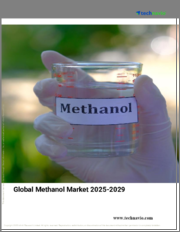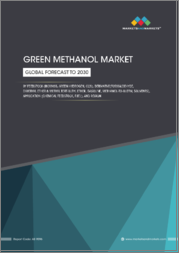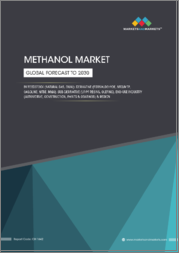
|
시장보고서
상품코드
1468651
메탄올 시장 보고서 : 용도별, 지역별(2024-2032년)Methanol Market Report by Application (Formaldehyde, Dimethyl ether, Gasoline, Chloromethane, MTBE/TAME, Acetic acid, and Others), and Region 2024-2032 |
||||||
세계 메탄올 시장 규모는 2023년 363억 달러에 달했습니다. IMARC 그룹은 2032년에는 552억 달러에 달하고, 2024-2032년간 4.6%의 연평균 성장률(CAGR)을 나타낼 것으로 예측했습니다. 화학 산업의 급속한 확장, 항생제 및 항진균제 제조에 대한 제품 채택 확대, 자동차 산업의 괄목할만한 성장, 다양한 정부 이니셔티브의 시행이 시장을 이끄는 주요 요인 중 일부입니다.
목질 알코올로도 알려진 메탄올(CH3OH)은 무색의 가연성 액체로 용매, 연료, 부동액으로 사용됩니다. 메틸기(CH3)와 수산기(OH)가 결합된 가장 단순한 알코올입니다. 메탄올은 목재와 같은 바이오매스로부터 천연가스나 석탄에서 추출한 합성가스를 파괴적 증류 또는 촉매 전환으로 알려진 공정을 통해 생산됩니다. 메탄올은 물, 알코올, 에테르, 케톤 및 기타 유기 용매와 섞일 수 있습니다. 따라서 포름알데히드, 아세트산, 디메틸테레프탈레이트(DMT), 메틸타샤리부틸에테르(MTBE), 타샤리아밀메틸에테르(TAME), 디메틸에테르(DME), 바이오디젤의 제조에도 널리 사용되고 있습니다.
자동차 산업의 괄목할만한 성장은 시장 전망을 밝게 하는 중요한 요인 중 하나입니다. 메탄올은 내연기관의 연료 및 자동차 라디에이터의 부동액으로 널리 사용되고 있습니다. 또한, 프로판의 대체품으로 일반적으로 사용되는 청정 연료인 디메틸 에테르(DME)를 생산하기 위해 에너지 부문에서 제품이 널리 사용되고 있는 것도 시장 성장을 가속하고 있습니다. 이와는 별도로, 산업 배출물에서 회수한 이산화탄소(CO2) 또는 대기 중 직접 회수하여 생산할 수 있는 재생 가능한 메탄올 시장 개척 및 상용화가 시장 성장에 탄력을 받고 있습니다. 또한, 소비자들 사이에서 환경에 대한 관심이 높아지면서 증발률이 낮고 복사열 에너지가 적어 보다 안전한 대체 연료로서 제품 수요가 증가하고 있는 것도 성장을 가속하는 요인으로 작용하고 있습니다. 또한 포름알데히드, 아세트산, MTBE(Methyl Tert-Butyl Ether), 디메틸 에테르(DME) 등 다양한 화학물질 생산에 널리 사용되고 있는 것도 시장 성장에 기여하고 있습니다. 기타 요인으로는 정부의 다양한 유리한 규제 시행, 광범위한 조사 개발(R&D) 활동, 접착제 및 페인트 생산에 대한 제품 채택 증가 등이 있으며, 이는 시장에 유익한 성장 기회를 제공합니다.
메탄올 시장 동향 및 촉진요인 :
화학 산업에서 광범위한 제품 채택
메탄올은 다양한 화학물질 및 화학 중간체를 제조하기 위한 범용성이 높은 원료로 화학 산업에서 널리 사용되고 있습니다. 화학 원료로서의 범용성으로 인해 널리 사용되고 있으며, 반응성, 용해성, 취급 용이성 등의 특성으로 인해 다양한 화학 공정에서 필수적인 성분으로 사용되고 있습니다. 또한 메탄올은 비닐 아세테이트 모노머(VAM), 무수 아세트산, 각종 에스테르의 제조에 사용되는 화학물질인 아세트산의 제조에 필수적인 원료로 작용합니다. 이에 따라 아세트산과 그 유도체는 섬유, 필름, 페인트, 용제 및 기타 산업 제품 생산에 사용됩니다.
자동차 산업에서의 괄목할만한 성장
메탄올은 휘발유와 일정 비율로 혼합할 수 있어 승용차 내연기관의 대체 연료로 널리 사용되고 있습니다. 또한 배출가스를 줄이고 연비를 향상시켜 성장 촉진요인으로 작용하고 있습니다. 또한, 메탄올은 높은 옥탄가와 우수한 노킹 저항성을 제공하여 엔진 성능을 향상시킬 수 있기 때문에 드래그 레이싱, 오벌 트랙 레이싱과 같은 프로 모터스포츠에서 연료로 사용되고 있습니다. 이 외에도 전기화학 반응을 통해 메탄올을 전기로 변환하는 전기자동차(EV)의 대체 동력원으로 널리 활용되고 있는 것도 시장 성장을 뒷받침하고 있습니다.
광범위한 조사 개발(R&D) 활동
메탄올 시장은 다양한 혁신으로 이어지는 광범위한 연구개발 활동을 통해 지속적으로 진화하고 있습니다. 또한 바이오매스, 산업 폐기물 가스, 회수된 이산화탄소(CO2)와 같은 비화석 연료 원료에서 생산되는 재생 가능한 메탄올의 채택이 시장 성장을 가속하고 있습니다. 또한, 연구자들은 메탄올 합성의 선택성, 활성 및 안정성을 향상시키는 첨단 촉매를 지속적으로 개발하고 있으며, 이는 시장 성장에 긍정적인 영향을 미치고 있습니다. 이 외에도 메탄올 생산에 대한 선택의 폭을 넓히고 지속가능성을 촉진하기 위해 이산화탄소 활용 및 바이오매스 전환과 같은 첨단 기술을 모색하는 연구 개발이 진행되고 있으며, 이는 시장 성장을 크게 촉진하고 있습니다.
목차
제1장 서문
제2장 조사 범위와 조사 방법
- 조사 목적
- 이해관계자
- 데이터 소스
- 1차 정보
- 2차 정보
- 시장 추정
- 보텀업 접근
- 톱다운 접근
- 조사 방법
제3장 주요 요약
제4장 서론
- 개요
- 물리적·화학적 특성
- 주요 산업 동향
제5장 세계의 메탄올 산업
- 시장 개요
- 시장 실적
- 수량 동향
- 매출 동향
- COVID-19의 영향
- 가격 동향
- 주요 가격 지표
- 가격 구조
- 가격 동향
- 시장 예측
- SWOT 분석
- 개요
- 강점
- 약점
- 기회
- 위협
- 밸류체인 분석
- 개요
- 원재료 채굴 및 추출
- 제조
- 마케팅
- 유통
- 수출
- 최종 용도
- 마진 분석
- Porter의 Five Forces 분석
- 개요
- 바이어의 교섭력
- 공급 기업의 교섭력
- 경쟁 정도
- 신규 진출업체의 위협
- 대체품의 위협
- 무역 데이터
- 수입
- 수출
- 시장 성장 촉진요인과 성공 요인
제6장 주요 지역 퍼포먼스
- 중국
- 아시아태평양(중국 제외)
- 유럽
- 북미
- 라틴아메리카
- 중동 및 아프리카
제7장 시장 분석 : 용도별
- 포름알데히드
- 디메틸에테르
- 가솔린
- 클로로메탄
- MTBE/TAME
- 아세트산
- 기타
제8장 경쟁 구도
- 시장 구조
- 시장 분석 : 주요 시장 진출기업별
- 주요 기업 개요
제9장 메탄올 제조 공정
- 제품 개요
- 관여하는 화학반응
- 세부 프로세스 플로우
- 원료 요건
- 매스 밸런스와 원료 전환율
제10장 메탄올 원료 분석
- 석탄
- 시장 실적
- 수량 동향
- 가격 동향
- 가격 동향
- 시장 분석 : 지역별
- 시장 분석 : 용도별
- 시장 실적
- 천연가스
- 시장 실적
- 수량 동향
- 가격 동향
- 가격 동향
- 시장 분석 : 지역별
- 시장 분석 : 용도별
- 시장 실적
The global methanol market size reached US$ 36.3 Billion in 2023. Looking forward, IMARC Group expects the market to reach US$ 55.2 Billion by 2032, exhibiting a growth rate (CAGR) of 4.6% during 2024-2032. The rapidly expanding chemical industry, widespread product employment in manufacturing antibiotics and antifungals, significant growth in the automotive industry, and the implementation of various government initiatives are some of the major factors propelling the market.
Methanol (CH3OH), also known as wood alcohol, is a colorless, flammable liquid that is used as a solvent, fuel, and antifreeze. It is the simplest alcohol and consists of a methyl group (CH3) linked to a hydroxyl group (OH). It can be produced through several processes, including from biomass, such as wood, through a process known as destructive distillation or catalytic conversion of synthesis gas derived from natural gas or coal. Methanol is miscible in water, alcohol, ether, ketones, and other organic solvents. As a result, it is also widely used in the production of formaldehyde, acetic acid, dimethyl terephthalate (DMT), methyl tertiary butyl ether (MTBE), tertiary amyl methyl ether (TAME), dimethyl ether (DME), and biodiesel.
The significant growth in the automotive industry is one of the key factors creating a positive outlook for the market. Methanol is widely used as a fuel in internal combustion engines and an antifreeze agent for automobile radiators. Moreover, the widespread product utilization in the energy sector to manufacture dimethyl ether (DME), a clean fuel that is commonly used as a substitute for propane, is favoring the market growth. Apart from this, the development and commercialization of renewable methanol, which can be produced from carbon dioxide (CO2) captured from industrial emissions or direct air capture, are providing an impetus to the market growth. Additionally, the increasing product demand as a safer fuel alternative due to its low rate of evaporation and low radiant heat energy owing to the rising environmental concerns among consumers is acting as another growth-inducing factor. Furthermore, the widespread product utilization for the production of various chemicals, such as formaldehyde, acetic acid, methyl tert-butyl ether (MTBE), and dimethyl ether (DME), is contributing to the market growth. Other factors, including the implementation of various favorable government regulations, extensive research and development (R&D) activities, and the increasing product employment in the manufacturing of adhesives, paints are presenting remunerative growth opportunities for the market.
Methanol Market Trends/Drivers:
The widespread product adoption in the chemical industry
Methanol is widely used in the chemical industry as a versatile raw material to produce various chemicals and chemical intermediates. It is widely used due to its versatility as a chemical feedstock, and its properties, such as its reactivity, solvency, and ease of handling, make it an essential component in various chemical processes. Moreover, methanol serves as a vital feedstock for producing acetic acid, a chemical used to manufacture vinyl acetate monomer (VAM), acetic anhydride, and various esters. In line with this, acetic acid and its derivatives are used to produce fibers, films, paints, solvents, and other industrial products.
Significant growth in the automotive industry
Methanol is widely used as an alternative fuel for internal combustion engines in passenger vehicles as it can be blended with gasoline in certain proportions. It also reduces emissions and improves fuel efficiency, which in turn is acting as a growth-inducing factor. Additionally, methanol is used as a fuel in professional motorsports such as drag racing and oval track racing as it offers high octane ratings and excellent knock resistance, allowing for increased engine performance. Apart from this, the widespread product utilization as an alternative power source for electric vehicles (EVs), where methanol is converted into electricity through electrochemical reactions, is supporting the market growth.
Extensive research and development (R&D) activities
The methanol market is continuously evolving due to the extensive R&D activities leading to various innovations. Moreover, the introduction of renewable methanol produced from non-fossil fuel feedstocks, such as biomass, industrial waste gases, or captured carbon dioxide (CO2), is propelling the market growth. Additionally, researchers are continuously working on developing advanced catalysts with improved selectivity, activity, and stability for methanol synthesis, which is positively influencing the market growth. Besides this, ongoing research and development efforts are exploring advanced technologies such as carbon dioxide utilization and biomass conversion to further expand the range of methanol production options and promote sustainability, which is providing a considerable boost to the market growth.
Methanol Industry Segmentation:
IMARC Group provides an analysis of the key trends in each segment of the global methanol market report, along with forecasts at the global and regional levels from 2024-2032. Our report has categorized the market based on the application.
Breakup by Application:
Formaldehyde
Dimethyl ether
Gasoline
Chloromethane
MTBE/TAME
Acetic acid
Others
Formaldehyde dominates the methanol market
The report has provided a detailed breakup and analysis of the methanol market based on the application. This includes formaldehyde, dimethyl ether, gasoline, chloromethane, MTBE/TAME, acetic acid, and others. According to the report, formaldehyde represented the largest market segment.
Methanol is a key raw material in the production of formaldehyde, which is a colorless gas with a pungent odor. It is widely used in manufacturing resins, plastics, textiles, and various household products. Formaldehyde is also used to make various resins, including urea-formaldehyde (UF), phenol-formaldehyde (PF), and melamine-formaldehyde (MF) resins. These resins are widely employed in the manufacture of plywood, particleboard, laminates, adhesives, coatings, and composite materials. Besides this, ethanol is used commercially as a stabilizer in formaldehyde solutions and generates hemiacetal or acetal compounds that prevent the formaldehyde's precipitation.
Breakup by Region:
China
Asia Pacific (excluding China)
Europe
North America
Latin America
Middle East and Africa
China exhibits a clear dominance in the market, accounting for the largest methanol market share
The report has also provided a comprehensive analysis of all the major regional markets, which include China, Asia Pacific (excluding China), Europe, North America, Latin America, and Middle East and Africa. According to the report, China represented the largest market for methanol.
China is one of the largest consumers and producers of methanol, which is used in diverse applications ranging from fuel and energy sources to chemicals and industrial processes. Methanol serves as a vital feedstock to produce various chemicals and chemical intermediates in China. It is used in the production of formaldehyde, acetic acid, methylamines, methyl methacrylate (MMA), dimethylformamide (DMF), and other chemicals that find applications in industries such as plastics, textiles, adhesives, and coatings. Moreover, China is a significant producer and consumer of dimethyl ether (DME), which is synthesized from methanol and is used as a clean-burning alternative to diesel fuel in transportation.
Competitive Landscape:
Several key market players are significantly investing in research and development (R&D) projects to explore innovative methods to improve methanol production processes. Additionally, the development of advanced catalysts, novel reactor designs, and optimization of process conditions to enhance methanol yield and energy efficiency and reduce environmental impacts is supporting the market growth. Furthermore, growing strategic partnerships between top companies, industry players, academic institutions, and research organizations to advance methanol-related technologies are further driving the market growth. Besides this, the leading market players and various manufacturers are investing in R&D activities to develop advanced production methods, such as the BASF and ICI processes. Several companies are also expanding their production capacities by establishing new plants to serve the growing markets and gain a competitive advantage.
Recent Developments:
In 2023, BASF SE signed an agreement with Linde Engineering to develop a new process for producing methanol from carbon dioxide. The process uses renewable energy sources, such as wind and solar power, to convert carbon dioxide into methanol, which can then be used as a fuel or chemical feedstock.
Mitsubishi Gas Chemical became the first company in Japan to successfully synthesize natural gas into methanol. The company also developed methanol-to-olefins (MTO) technology that converts methanol to olefins, which are used as feedstocks for producing various chemicals and plastics.
In 2021, Celanese Corporation expanded its methanol production from recycled CO2 to support environmental targets. In recent years, Celanese Corporation has continued to be involved in the methanol industry, with a focus on sustainability and reducing the environmental impact of methanol production.
Key Questions Answered in This Report
- 1. What was the global methanol market size in 2023?
- 2. What will be the global methanol market outlook during the forecast period (2024-2032)?
- 3. What are the global methanol market drivers?
- 4. What are the major trends in the global methanol market?
- 5. What is the impact of COVID-19 on the global methanol market?
- 6. What is the global methanol market breakup by application?
- 7. What are the major regions in the global methanol market?
Table of Contents
1 Preface
2 Scope and Methodology
- 2.1 Objectives of the Study
- 2.2 Stakeholders
- 2.3 Data Sources
- 2.3.1 Primary Sources
- 2.3.2 Secondary Sources
- 2.4 Market Estimation
- 2.4.1 Bottom-Up Approach
- 2.4.2 Top-Down Approach
- 2.5 Forecasting Methodology
3 Executive Summary
4 Introduction
- 4.1 Overview
- 4.2 Physical and Chemical Properties
- 4.3 Key Industry Trends
5 Global Methanol Industry
- 5.1 Market Overview
- 5.2 Market Performance
- 5.2.1 Volume Trends
- 5.2.2 Value Trends
- 5.3 Impact of COVID-19
- 5.4 Price Trends
- 5.4.1 Key Price Indicators
- 5.4.2 Price Structure
- 5.4.3 Price Trends
- 5.5 Market Forecast
- 5.6 SWOT Analysis
- 5.6.1 Overview
- 5.6.2 Strengths
- 5.6.3 Weaknesses
- 5.6.4 Opportunities
- 5.6.5 Threats
- 5.7 Value Chain Analysis
- 5.7.1 Overview
- 5.7.2 Raw Material Mining and Extraction
- 5.7.3 Manufacturing
- 5.7.4 Marketing
- 5.7.5 Distribution
- 5.7.6 Export
- 5.7.7 End Use
- 5.8 Margin Analysis
- 5.9 Porter's Five Forces Analysis
- 5.9.1 Overview
- 5.9.2 Bargaining Power of Buyers
- 5.9.3 Bargaining Power of Suppliers
- 5.9.4 Degree of Competition
- 5.9.5 Threat of New Entrants
- 5.9.6 Threat of Substitutes
- 5.10 Trade Data
- 5.10.1 Imports
- 5.10.2 Exports
- 5.11 Key Market Drivers and Success Factors
6 Performance of Key Regions
- 6.1 China
- 6.1.1 Market Trends
- 6.1.2 Market Forecast
- 6.2 Asia Pacific (Excluding China)
- 6.2.1 Market Trends
- 6.2.2 Market Forecast
- 6.3 Europe
- 6.3.1 Market Trends
- 6.3.2 Market Forecast
- 6.4 North America
- 6.4.1 Market Trends
- 6.4.2 Market Forecast
- 6.5 Latin America
- 6.5.1 Market Trends
- 6.5.2 Market Forecast
- 6.6 Middle East and Africa
- 6.6.1 Market Trends
- 6.6.2 Market Forecast
7 Market Breakup by Application
- 7.1 Formaldehyde
- 7.1.1 Market Trends
- 7.1.2 Market Forecast
- 7.2 Dimethyl Ether
- 7.2.1 Market Trends
- 7.2.2 Market Forecast
- 7.3 Gasoline
- 7.3.1 Market Trends
- 7.3.2 Market Forecast
- 7.4 Chloromethane
- 7.4.1 Market Trends
- 7.4.2 Market Forecast
- 7.5 MTBE/TAME
- 7.5.1 Market Trends
- 7.5.2 Market Forecast
- 7.6 Acetic Acid
- 7.6.1 Market Trends
- 7.6.2 Market Forecast
- 7.7 Others
- 7.7.1 Market Trends
- 7.7.2 Market Forecast
8 Competitive Landscape
- 8.1 Market Structure
- 8.2 Market Breakup by Key Players
- 8.3 Key Player Profiles
9 Methanol Manufacturing Process
- 9.1 Product Overview
- 9.2 Chemical Reactions Involved
- 9.3 Detailed Process Flow
- 9.4 Raw Material Requirements
- 9.5 Mass Balance and Feedstock Conversion Rates
10 Methanol: Feedstock Analysis
- 10.1 Coal
- 10.1.1 Market Performance
- 10.1.1.1 Volume Trends
- 10.1.1.2 Value Trends
- 10.1.2 Price Trends
- 10.1.3 Market Breakup by Region
- 10.1.4 Market Breakup by Application
- 10.1.1 Market Performance
- 10.2 Natural Gas
- 10.2.1 Market Performance
- 10.2.1.1 Volume Trends
- 10.2.1.2 Value Trends
- 10.2.2 Price Trends
- 10.2.3 Market Breakup by Region
- 10.2.4 Market Breakup by Application
- 10.2.1 Market Performance



















